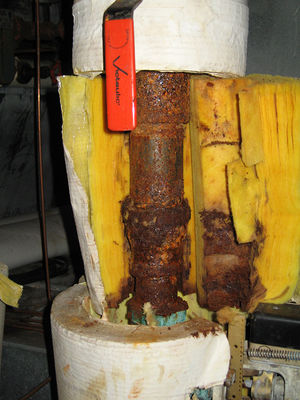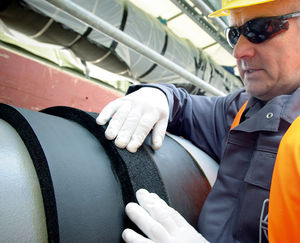 Two of the most significant variables for efficient mechanical system performance is insulation quality and proper insulation installation. Insulation solutions are used to reduce the heat transfer of system while preventing condensation. In addition to insulation quality and installation being paramount, choosing the correct thickness is crucial in slowing heat transfer to achieve long-term thermal and condensation control. Under-insulated chilled piping and equipment will cause surface condensation build up and eventually, this uncontrolled condensation will lead to corrosion under insulation (CUI), saturated insulation, thermal energy loss, mold & mildew growth, and system failure.
Two of the most significant variables for efficient mechanical system performance is insulation quality and proper insulation installation. Insulation solutions are used to reduce the heat transfer of system while preventing condensation. In addition to insulation quality and installation being paramount, choosing the correct thickness is crucial in slowing heat transfer to achieve long-term thermal and condensation control. Under-insulated chilled piping and equipment will cause surface condensation build up and eventually, this uncontrolled condensation will lead to corrosion under insulation (CUI), saturated insulation, thermal energy loss, mold & mildew growth, and system failure.
To ensure system success it is important to gather the appropriate information to determine the correct insulation thickness calculations.
- Pipe, duct, or vessel type (copper, iron, steel, PVC, etc.)

- Pipe or duct size and length
- Process (line) temperature
- Ambient temperature
- Relative humidity
- Wind speed (exterior applications)
- Type of cladding, if used
- Indoor or outdoor application
This information will be used in the heat flow equation to determine the insulation thickness required to maintain a surface temperature above the dew point and prevent condensation.
Thermal conductivity, often referred to as K-value, is the rate of steady heat flow through a unit area of a homogeneous material induced by a unit temperature gradient in a direction perpendicular to that unit area. Definition aside, the most important thing to know is the lower the K-value, the higher the insulating value. Another important thing to know about the K-value is that it changes depending on mean temperature, meaning as the average temperature goes up, so does the K-value. Thermal resistance, better known as R-value, is the insulation's resistance to heat flow. Therefore, the higher the R-value, the greater the insulating power. R-value is dependent on the K-value and thickness of the insulation and for flat insulation, like duct liner, the R-value is simply the thickness divided by the K-value. For cylindrical insulation on pipes, the calculation is more complicated and relies also on the inner diameter of the insulation with smaller inner diameters having higher R-values for a given insulation thickness. Thermal conductance, or C-factor, is the rate of heat flow through a specified thickness of insulation and is the reciprocal of the R-value. This means that the lower the C-factor, the better the insulator. The C-factor for flat insulation is the K-value divided by the thickness of the insulation.
Calculations Made Easy with ArmaWin

Seems simple, right? Is your head spinning with math calculations? not to worry, this process can be made easier by using the ArmaWin app, which is our technical calculator that helps determine the right technical values, like thickness, to be specified on a job using the ArmaFlex® family of products. ArmWin (soon to be named ArmaWin™) can be used on mobile devices such as smartphones or tablets as well as on your computer. This powerful tool can be used to carry out all the common technical calculations in refrigeration, plumbing, air-conditioning, and heating applications. Users of app can even save or email project-related results – even on the job site. The ArmaWin is available for Apple iOS and Android operating systems and works best on Firefox and Chrome web browsers. With this tool, anyone can calculate the proper thickness of ArmaFlex to meet design requirements, whether that be condensation control, energy conservation, or freeze protection.
Check out how ArmaWin works here.
